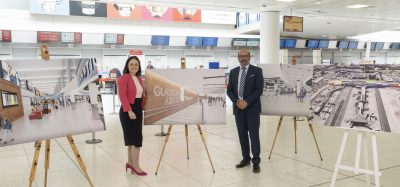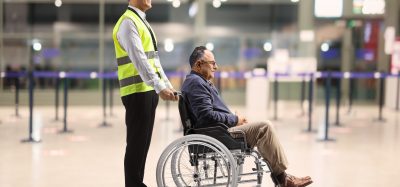Tackling air travel confidence post-pandemic with digital technology at Albany Airport
- Like
- Digg
- Del
- Tumblr
- VKontakte
- Buffer
- Love This
- Odnoklassniki
- Meneame
- Blogger
- Amazon
- Yahoo Mail
- Gmail
- AOL
- Newsvine
- HackerNews
- Evernote
- MySpace
- Mail.ru
- Viadeo
- Line
- Comments
- Yummly
- SMS
- Viber
- Telegram
- Subscribe
- Skype
- Facebook Messenger
- Kakao
- LiveJournal
- Yammer
- Edgar
- Fintel
- Mix
- Instapaper
- Copy Link
Posted: 27 January 2021 | Albany International Airport | No comments yet
Restoring passenger confidence in air travel will be imperative to the survival of the aviation industry post-COVID-19. Albany International Airport spoke to International Airport Review’s Leah Hockley about the digital approach that they believe will be key in achieving this objective.


Credit: Albany International Airport - Philip Calderone, CEO of Albany International Airport.
Albany International Airport (ALB) in Upstate New York was looking forward to record enplanements in 2020. But, as the COVID-19 virus began to spread in February 2020, the Albany County Airport Authority’s (ACAA) focus shifted to protecting its travellers and staff from the ravages of the pandemic. Today, in cooperation with General Electric, Albany International Airport has become a Digital Incubator for post-pandemic air travel.
In mid-February 2020, the airport’s Chief Executive Officer, Philip Calderone, took the decisive step to create an Airport COVID-19 Task Force, tasked with delivering clear and up-to-date intelligence on the spread of the virus and to provide best practices that would enable the airport to ensure passenger safety from kerb to aircraft.
ALB’s Airport COVID-19 Task Force
An all-out response by the industry and airport management would be critical if we were to restore confidence in the day-to-day safe and secure operation of air travel”
“It became abundantly clear to me that the impact of COVID-19 on the nation’s airports and air travel would be prolonged and unrelenting,” said Philip Calderone, CEO of Albany International Airport. “An all-out response by the industry and airport management would be critical if we were to restore confidence in the day-to-day safe and secure operation of air travel.”
The Task Force included representatives from the New York State and Albany County Health Departments, the Transportation Security Administration (TSA), the Albany County Sheriff’s Office, the Albany Medical Center and Airport Authority Board member, Dr. Lyon Greenberg – all under the guidance established by the Centers for Disease Control and Prevention (CDC).
The airport’s initial preventative steps included:
- The mandatory wearing of protective masks and social distancing for all staff and travellers
- Non-stop cleaning and disinfecting of all airport touch surfaces
- Plexiglass barriers at airline and concession personal contact points
- Upgraded air filtration systems
- Continuous UV cleaning of escalators.


Credit: Albany International Airport
Supporting the workforce
Faced with the possible layoff of shuttle bus drivers and other workers, Calderone sought the support of the airport’s labour unions to ‘redeploy’ workers to assume tasks that had been assigned to outside contractors”
The Task Force was further charged with examining potential means of providing COVID-19 testing to over 500 airport workers and creating a social distancing programme once enplanements began to increase.
The precipitous drop in enplanements, up to 80 per cent on some days, forced the airport to close its largest parking lot. Faced with the possible layoff of shuttle bus drivers and other workers, Calderone sought the support of the airport’s labour unions to ‘redeploy’ workers to assume tasks that had been assigned to outside contractors. The unions accepted the proposal and Albany International Airport has not had to lay-off or furlough any of its employees.
Collaboration with General Electric
Albany International Airport is fortunate to be located within the shadow of General Electric’s (GE) Research and Development Center in Niskayuna, NY. Having worked closely with GE in the past, the airport sought guidance from the scientists at GE Research and General Electric Aviation.
The collaboration with General Electric Aviation resulted in the first digitally-focused airport aimed at demonstrating new technologies to make air travel safer in a post-pandemic world”
The collaboration with GE Aviation resulted in the first digitally-focused airport aimed at demonstrating new technologies to make air travel safer in a post-pandemic world, with Albany International Airport becoming the launch customer for GE Aviation’s new Wellness Trace App, which the airport has been using to track COVID-19 cleaning protocols. The airport and GE are expected to unveil advanced artificial intelligence (AI), machine learning and other digital technologies as part of the airport’s burgeoning Digital Incubator.
“We believe that the digital vision that Albany International Airport is advancing is exactly the kind of template that airports and airlines will need to ensure safe, healthy travel through the COVID-19 pandemic and beyond,” said Andrew Coleman, General Manager of GE Aviation’s Digital Group. “We’re proud to have Albany International sign on as our launch customer. The app is helping them closely track COVID-19 cleaning protocols today, with the potential to track other health screening, as the industry and regulators navigate safe travel in a post-pandemic world.”
The Wellness Trace App
The Wellness Trace App, secured by blockchain technology, provides a comprehensive platform for airports and airlines to track COVID-19 screening for both passengers and employees and set protocols for tracking the cleaning of objects in the airport or aboard aircraft to ensure that they are regularly disinfected.
As Albany’s touchpoints are cleaned, a member of staff enters the location and time into a platform that allows travellers and staff to access the app and view when touch areas were last cleaned.
Travellers can then access the information by using their mobile device camera to scan a QR code at any of the airport’s locations. The app will then identify the location and the time that the touch point was last cleaned and disinfected.


Credit: Albany International Airport
COVID-19 testing
Quick and accurate COVID-19 testing is an essential measure that will help to restore confidence in air travel, which is critical to the nation’s economy”
In December 2020, the Airport Authority began offering low-cost COVID-19 testing to all travellers and staff. The test – developed by the SUNY Upstate Medical University in Syracuse, in cooperation with Quadrant Biosciences – is a saliva-based test that is self-administered. The user swabs the inside of their cheeks, inserts the swab into a small vial containing a reagent, shakes it several times and gives it to the test attendant. Test results are then confirmed within 48 hours.
“The SUNY-Quadrant Bioscience test has been rated as the number one test in the world for identifying the COVID-19 virus, and we are extremely pleased with the initial response of Albany travellers that have elected to take advantage of our testing programme,” said Calderone. “Quick and accurate COVID-19 testing is an essential measure that will help to restore confidence in air travel, which is critical to the nation’s economy.”
Official accreditations
Albany soon recognised that airlines and airports were following our progress, but believed it incumbent to seek verification of our overall procedures. Albany International Airport was recently rewarded with accreditation from The Global Biorisk Advisory Council (GBAC), which validated Albany International Airport’s aggressive response to COVID-19 with full GBAC STAR Accreditation, noting that Albany had implemented the most stringent protocols for cleaning, disinfecting and infectious disease prevention in its facilities.
The airport has also received the Airport Health Accreditation (AHA) from Airports Council International (ACI) World. The Airport Health Measures Audit Program (AHMAP) reviewed and approved the airport’s programme that measured the effectiveness of all airport health measures implemented to prevent the spread of infectious disease, with the aim of reassuring the travelling public through an on-site audit.
“These awards represent the industry standards for outbreak prevention, response and recovery accreditation and validates the airport’s preparedness for biorisk situations, such as the COVID-19 virus,” said Calderone. “The accreditation confirms the airport’s performance-based programme for cleaning, disinfecting and infection prevention, and further verifies Albany International Airport’s dedication to maintaining and carrying out the procedures on a daily basis.”
Light at the end of the tunnel
There is light at the end of the long COVID-19 tunnel, but we must continue to remain vigilant in our fight”
To be certain, we are still in the battle with COVID-19. The vaccines that are rapidly being deployed and administered will help to reduce the spread of the virus. The successful restoration of confidence in air travel now rests with airport management, airline executives, innovative science and our nation’s leadership.
“There is light at the end of the long COVID-19 tunnel, but we must continue to remain vigilant in our fight. This is an opportunity to reimagine air travel, and I’m proud that, at Albany International Airport, we have already begun the transformation to the smart airport of our future,” said Calderone.
Related topics
Airport crisis management, Airside operations, Apps, COVID-19, Digital transformation, New technologies, Passenger experience and seamless travel, Passenger volumes, Safety, Terminal operations, Workforce
Related airports
Related organisations
Airports Council International (ACI World), Albany County Airport Authority (ACAA), Centers for Disease Control and Prevention (CDC), General Electric, General Electric Aviation, Transportation Security Administration (TSA)


















